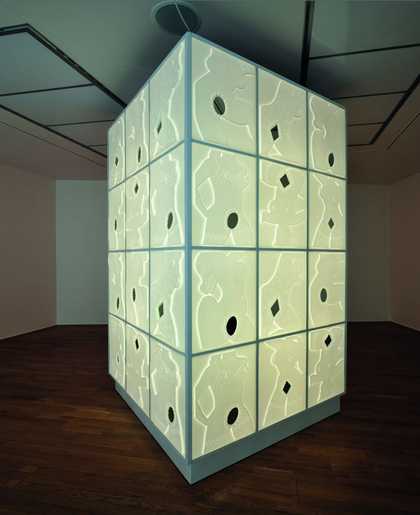Born 1941 in Olomouc, Czechoslovakia. Lives and works in Bratislava, Slovakia.

Jana Želibská installing her work Kandarya – Mahadeva in 1969
© Jana Želibská
Photo: Jan Ságl
Jana Želibská studied at the Academy of Fine Art and Design in Bratislava and graduated in graphics and book illustration in 1965. In 1968 Želibská received a scholarship for a residency in Paris, where she witnessed the 1968 protests. Belonging to a generation of progressive artists in Czechoslovakia, she was inspired by nouveau réalisme as well as pop art. Želibská rapidly moved on from experimenting with lyrical painting and prints in her early years, to creating immersive environments, using mixed media and non-art materials.
Jana Želibská created the first of such environments, entitled The Possibility of Exposure 1967, for a solo exhibition at the Cyprian Majernik Gallery in Bratislava and comprised paintings, assemblages and freestanding objects. Viewers could manipulate elements of the exhibited paintings and assemblages, featuring fragments of female bodies, divided by sheer curtains. Inspired by nouveau réalisme’s use of non-art material, the work combined mirrors, fabric, neon and plastics. In one of the paintings shown within the installation, entitled Breasts 1967, a breast adorned with lace and a patterned fabric is shown with its mirror image lightly concealed behind a sheer curtain. The viewer is encouraged to move the curtain to reveal the painting in its entirety, emulating intimate moments and engaging with the tactile qualities of the work.
Similarly, in Nose I-II 1967, two diagrammatic images are shown next to each other, reminiscent of ‘before and after’ pictures depicting cosmetic surgery or self-improvement techniques. The two noses are, however, identical. Other works within the environment include Object II 1967 and a column entitled Kandarya – Mahadeva 1969, which refers to the eponymous temple in India and draws in elements of tantric Hinduism and erotic rituals. Covered in neon-outlined bodies of female dancers, with mirrors in place of their private parts, Želibská originally intended this work to be shown on the street, but was prohibited from doing so as the work was deemed too explicit.
Lina Džuverović
September 2015

